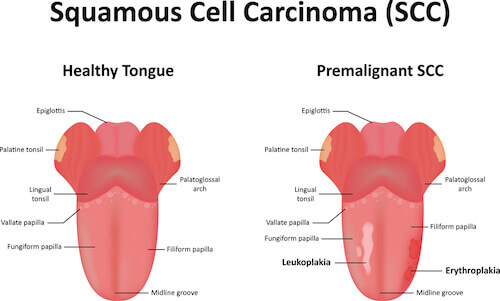
menu


Most head and neck cancers are relatively preventable since they are highly correlated with tobacco use and alcohol consumption. They are also generally curable if caught early. Symptoms to watch out for include painful swallowing, trouble breathing, ear pain, a lump in the neck that lasts longer than two weeks, a growth in the mouth and bleeding from the mouth, nose or throat.
Tobacco use is the most preventable cause of these deaths. In the United States, up to 200,000 people die each year from smoking-related illnesses. The good news is that this figure has decreased due to the increasing number of Americans who have quit smoking. The bad news is that some of these smokers switched to smokeless or spit tobacco, assuming it is a safe alternative. This is untrue. By doing so, they are only changing the site of the cancer risk from their lungs to their mouths. While lung cancer cases are decreasing, cancers in the head and neck appear to be increasing, but they are curable if caught early. Fortunately, most head and neck cancers produce early symptoms. You should know the potential warning signs so you can alert your doctor as soon as possible. Remember, —successful treatment of head and neck cancer depends on early detection. Knowing and recognizing its signs can save your life.
A lump in the neck. Cancers that begin in the head or neck usually spread to lymph nodes in the neck before they spread elsewhere. A lump in the neck that lasts more than two weeks should be seen by a physician as soon as possible. Of course, not all lumps are cancer. But a lump (or lumps) in the neck can be the first sign of cancer of the mouth, throat, voicebox (larynx), thyroid gland, or of certain lymphomas and blood cancers. Such lumps are generally painless and continue to enlarge steadily.
Change in the voice. Most cancers in the larynx cause some changes in voice. An Otolaryngologist is a head and neck specialist who can examine your vocal cords easily and painlessly. While most voice changes are not caused by cancer, you shouldn’’t take chances. If you are hoarse or notice voice changes for more than two weeks, see your doctor.
A growth in the mouth. Most cancers of the mouth or tongue cause a sore or swelling that doesn’’t go away. These may be painless, which can be misleading. Bleeding may occur, but often not until late in the disease. If an ulcer or swelling is accompanied by lumps in the neck, you should be concerned. In addition, any sore or swelling in the mouth that does not go away after a week should be evaluated by a physician. Your dentist or doctor can determine if a biopsy (tissue sample test) is needed and can refer you to a head and neck surgeon who can perform this procedure.
Bringing up blood. This is often caused by something other than cancer. However, tumors in the nose, mouth, throat, or lungs can cause bleeding. If blood appears in your saliva or phlegm for more than a few days, you should see your physician.
Swallowing problems. Cancer of the throat or esophagus (swallowing tube) may make swallowing solid foods— and sometimes liquids— difficult. The food may “stick” at a certain point and then either go through to the stomach or come back up. If you have trouble almost every time you try to swallow something, you should be examined by a physician. Usually a barium swallow x-ray or an esophagoscopy (direct examination of the swallowing tube with a scope) will be performed to find the cause.
Changes in the skin. The most common head and neck cancer is basal cell cancer of the skin. Fortunately, this is rarely serious if treated early. Basal cell cancers appear most often on sun-exposed areas like the forehead, face, and ears, but can occur almost anywhere on the skin. Basal cell cancer often begins as a small, pale patch that enlarges slowly, producing a central “dimple” and eventually an ulcer. Parts of the ulcer may heal, but the major portion remains ulcerated. Some basal cell cancers show color changes. Other kinds of cancer, including squamous cell cancer and malignant melanoma, also occur on the head and neck. Most squamous cell cancers occur on the lower lip and ear. They may look like basal cell cancers, and if caught early and properly treated, usually are not dangerous. If there is a sore on the lip, lower face, or ear that does not heal, consult a physician. Malignant melanoma typically produces a blue-black or black discoloration of the skin. However, any mole that changes size, color, or begins to bleed may mean trouble. A black or blue-black spot on the face or neck, particularly if it changes size or shape, should be seen as soon as possible by a dermatologist or other physician.
Persistent earache. Constant pain in or around the ear when you swallow can be a sign of infection or tumor growth in the throat. This is particularly serious if it is associated with difficulty in swallowing, hoarseness, or a lump in the neck.
These symptoms should be evaluated by an Otolaryngologist.

Oral cancers appear as red or white patches of mouth tissue or small ulcers that look like a canker sores, but are painless. Oral cancers usually form on the tongue or floor of the mouth, but can occur on any tissue in and around the mouth. This includes cancers of the tonsils, adenoids, uvula (soft palate), roof of the mouth (hard palate), inside the lining of the cheeks, the gums, teeth, lips, the area behind the wisdom teeth and salivary glands. Some of these lesions may be benign, others may be malignant, and still others are precancerous.
Leukoplakias: Leukoplakias consist of thick, white lesions that most commonly form beneath or around the tongue, cheeks or gums. These mouth sores are most often seen in tobacco users.
Erythroplakias: These lesions appear as a red, raised area in the mouth and have a higher incidence of becoming malignant than leukoplakias.
A biopsy is often needed to diagnose leukoplakias and erythroplakias.
Squamous cell carcinomas are the most common type of oral cancer. Less common are lymphoma and salivery gland cancers. Most oral cancers occur in people age 45 and older. When cancers of the mouth do metastasize, they are most likely to spread to the lymph nodes in the neck.
Malignant tissue in the bottom part of the pharynx is called hypopharyngeal cancer. The pharynx is a tube-like structure that goes from the back of the nose down to the windpipe and esophagus. Symptoms include sore throat and ear pain. Hypopharyngeal cancer is usually diagnosed through a physical examination, CT scan , MRI (magnetic resonance imaging), chest x-ray, esophogus x-ray or biopsy. Most hypopharyngeal cancers are squamous cell carcinomas – thin flat cells that line the inside of the organ. Unfortunately, this cancer tends to be detected in later stages because early symptoms are rare. This cancer typically requires surgery to remove the malignant tissue, followed by radiation and/or chemotherapy treatment.
Laryngeal cancer occurs when there is malignant tissue in the larynx. Symptoms include painful swallowing, trouble breathing, ear pain, a lump in the neck, persistent coughing, hoarseness and/or a change in voice. Over 90 percent of laryngeal cancers are squamous cell carcinomas, which respond well to surgery and radiation and/or chemotherapy.
Please refer to Laryngoscopy for more information on this procedure.
A mass (lump) of the head and neck is a common reason for patients to seek the consultation of an Ear, Nose, and Throat (ENT) physician. Masses of the head and neck may represent a variety of conditions such as infections, congenital lesions, benign growths, or malignant tumors. Physicians will determine the etiology of a head and neck mass by reviewing the patient’s symptoms.

The next step in evaluating a patient with a head and neck mass is to examine the patient. This includes a comprehensive examination of the head and neck.
Your doctor may recommend an imaging study such as ultrasound or CT scan to further evaluate the cause of the neck mass.
There are some benign (non-cancerous) masses that can literally occur ANYWHERE in the neck. Such benign masses include cysts, inflamed lymph nodes, and lipomas (fatty growths). In kids, other benign masses that can occur anywhere in the neck are lymphatic or vascular malformations. However, some benign neck masses generally occur in well-delineated locations of the neck. Biopsy will confirm a diagnosis.
The vast majority of infectious causes for neck masses are due to infected lymph nodes from an infection somewhere else in the head or neck (lymphadenitis). Lymphadenitis can occur ANYWHERE in the neck. If lymphadenitis gets bad enough, a neck lump may turn into an abscess (pocket of infected fluid). However, other underlying infectious processes may be going on contributing to a painful neck mass with overlying skin that is red and tender in certain distinct areas of the neck. Biopsy is usually not necessary, but a CT/MRI scan may be recommended by your doctor.
When a neck mass pops up due to cancer, it almost always is due to spread from another location, such as tonsil, throat, tongue, lung, etc. The one exception is lymphoma, which can pop up anywhere. Based on where the neck mass is, we can determine the most likely location of the main cancer to be, and a vigorous search for the main cancer will be performed by your doctor. Such a “vigorous search” may include endoscopy, CT/MRI scans, chest X-rays, blood tests, etc. Some signs that suggest a neck mass may be due to cancer are neck pain, rock hard (indurated), fixed in position (immobile), adherent to surrounding tissues and muscles, and slowly enlarging. Biopsy is required for diagnosis.
If you have a neck mass, make an appointment to see one of our Otolaryngologists for evaluation.